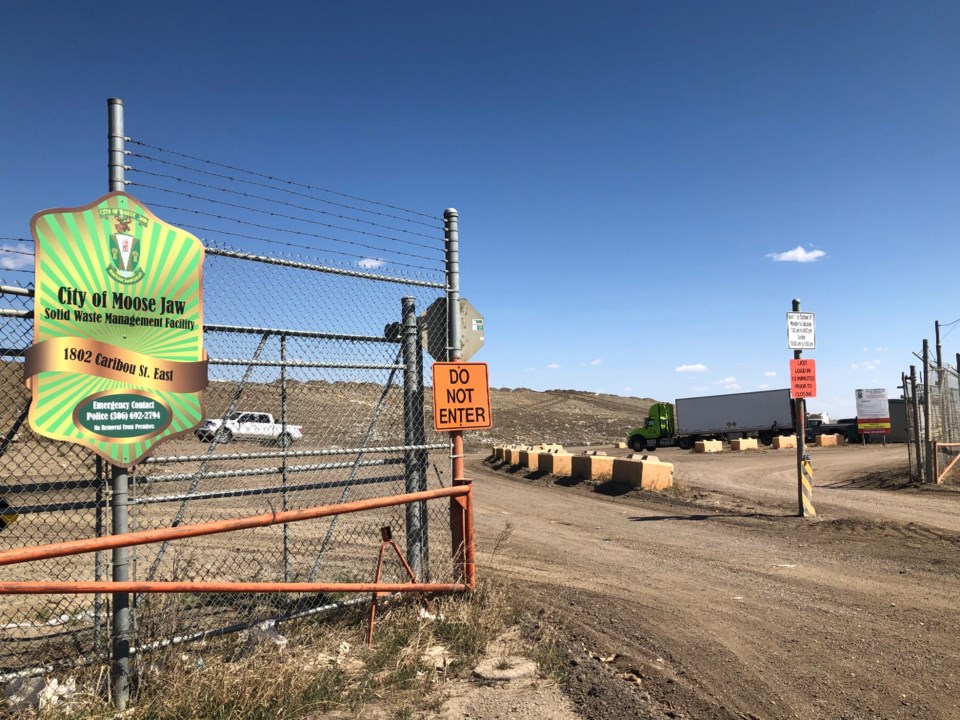MOOSE JAW — City administration has been predicting the end of the landfill for more than two decades, but after a recent assessment, it says the venue will likely be finished by 2030.
City hall has conducted several assessments during the past few years while it searched for a new solid waste management venue site, administration told city council during its Oct. 7 executive committee meeting.
For example, an analysis in September 2022 found that the average fill rate was 4,230 cubic metres per month from 2017 to September 2021, which meant the landfill would reach a capacity elevation of 577 metres by March 2026.
During an airspace assessment in September 2023, the analysis determined that the average fill rate had remained the same between September 2021 and July 2023, which meant the dump would likely reach the 577-metre elevation by August 2026.
However, in early October, staff calculated that the average airspace fill rate was 7,270 cubic metres per month from July 2023 to May 2024. This was due to an increase in tonnage received from the Buffalo Pound Water Treatment Plant from its upgrades and ongoing operations.
Engineering services staff also calculated that the average fill rate per month during that period was 5,750 cubic metres, which meant the 577-metre elevation had been reached. Therefore, city hall expected the peak elevation to be 584 metres by October 2028, which meant the landfill was now operating in “contingency airspace.”
Change is needed
“We need to change the way we run that facility. Where we are right now, the landfill is full … ,” said Bevan Harlton, director of operations. “If we increase it to 584 metres, we can buy another four years. If we put forward our best efforts at diversion … we can stretch that to 2030.”
Harlton noted that in 2023, the landfill collected 76,671.66 tonnes from the three sources, while it accepted — excluding dirty materials — 1.2 million kilograms of recycling items. This cost the city $3.9 million to provide these services.
Final planning
Meanwhile, with the help of a contractor, city administration will create a 2025 landfill operations plan using this year’s plan as the foundation. This document — to focus on landfill management and diversion efforts — will inform changes and help city hall anticipate operational costs.
Furthermore, administration will create the final landfill operations plan from 2026 to 2030, he said. It will also consult with Buffalo Pound and the Ministry of Environment about how to manage the plant’s sludge material at a different location.
“It’s a byproduct that is not going away (anytime) soon. Their capital project is working to reduce that, but in the meantime, it has to be managed,” Harlton stated.
Extra measures
City administration is considering interim measures that include immediately adding extra paper and cardboard bins at the landfill, improving the bulk recycling depot at 1100 High Street West, and making the composting program more accessible.
Further, it is reviewing the historic tonnages and trends for weekly and biweekly waste collection, and for now, will keep those pickup schedules intact.
Harlton added that the city can keep accepting waste until 2030 only if the average monthly fill rate remained at 4,230 cubic metres.
City manager Maryse Carmichael said she and Harlton met recently during a hybrid in-person/online meeting with the surrounding rural municipalities to inform them about the report and its contents. She pointed out that other users of the landfill need to be aware of the 2030 closure date.
A maximum height
Harlton told council that the 577-metre elevation is a “pretty old” number that city administration has held to for years. Directors have understood that if the city goes beyond that number, it could affect operational and customer service activities.
Asked if the Ministry of Environment had implemented a maximum airspace height, Harlton said the 584-metre maximum elevation is as high as the city can go without equipment falling off the sides.
The operations director acknowledged that the city could reach 584 metres before 2030, although it has been tracking this situation since 2021. The situation will depend on the 2025 operating plan and whether it’s viable to continue operating the site and bringing waste there.
“We are moving into contingency. This is not free space … it’s a pyramid that is not yet pointed,” he said. “Our hope is that we can find ways to continue to use this facility, but it’s not where we want it to be.”
Buffalo Pound a priority
Harlton noted that the operating plan would determine whether the city should accept or deny waste from some entities. He pointed out that Moose Jaw owns 26 per cent of the Buffalo Pound plant, so he wanted to prioritize that relationship, continue collecting revenue from it and store the sludge off-site if necessary.
Asked whether the landfill height could affect 15 Wing or the municipal airport, Harlton said he hadn’t heard any concerns from those groups. This is likely because the province allowed the dump there through a grandfather clause.
Chiming in, Carmichael said the dump’s height shouldn’t be a problem since it was already in a restricted zone near the city.
East versus west
Coun. Jamey Logan thought the city could store the sludge on the landfill’s east side, which would increase its longevity. Meanwhile, he wondered if they could reopen the dump’s west side — it was under 577 metres — to acquire a few more years of life there.
City hall discussed that with the province, but factors that limit extending the landfill in that direction include nearby waterways, Highway 1, 15 Wing flyovers and existing site contamination, said Harlton. If the ministry approved the use of the west side, the city would have to remove the contaminated soil and install a leachate management system because the expansion would be considered a new build.
“… the cost would be considerable,” he added.
The next regular council meeting is Monday, Oct. 21.




